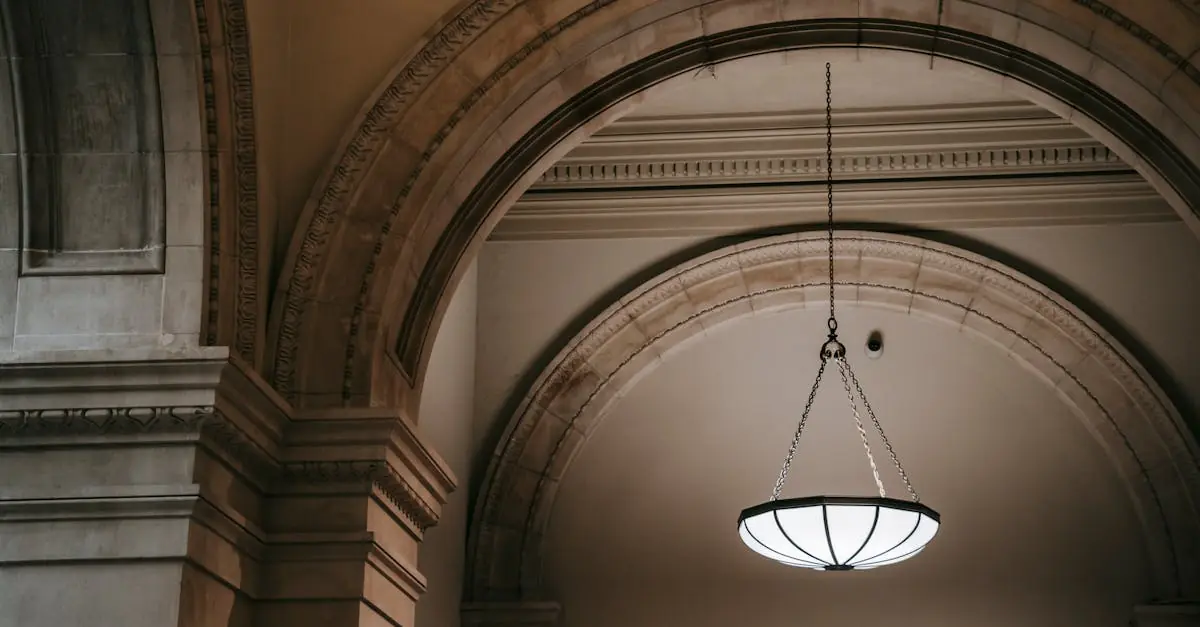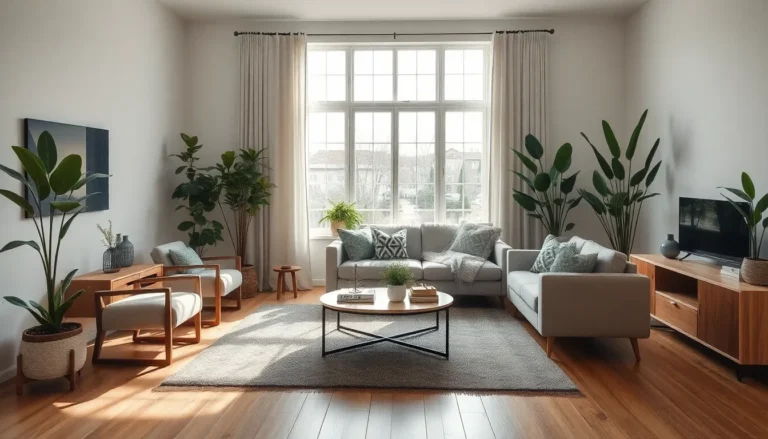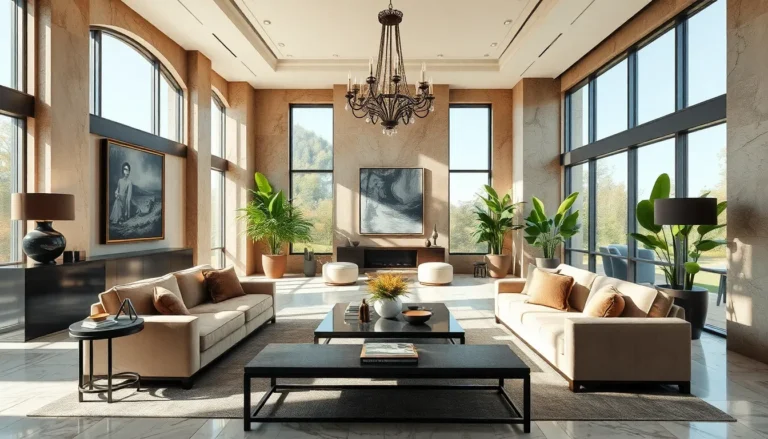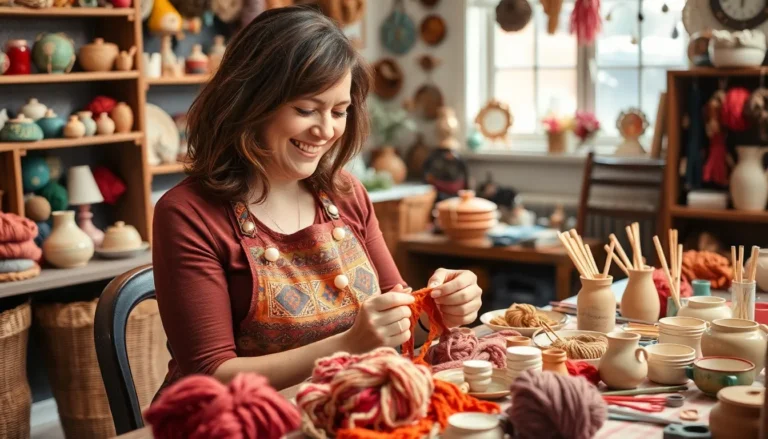Table of Contents
ToggleArched doorways have a way of turning heads and raising eyebrows, much like that one friend who insists on wearing socks with sandals. They blend elegance with functionality, inviting guests into spaces that feel both grand and cozy. Whether it’s a charming cottage or a sleek modern home, these architectural gems add a touch of flair that straight-edged doors just can’t compete with.
Overview of Arched Doorway Design
Arched doorways serve as striking architectural features that can elevate the design of any home. These shapes create a natural flow between spaces, inviting light while adding a sense of grandeur. The gentle curves soften the hard lines of surrounding walls, establishing a welcoming ambiance.
In residential applications, arched doorways fit various styles, from traditional to modern. Many homeowners opt for these designs to reflect their personal taste while maintaining functionality. They offer spaciousness without overwhelming, making rooms feel expansive and open.
Materials used in arched doorways vary widely, with options like wood, metal, and stone. Each material brings its unique character and contributes to the overall aesthetic. Wood remains popular for its warmth, while stone adds a dramatic flair, particularly in rustic or Mediterranean homes.
Consider integrating decorative elements for further enhancement. Intricate moldings, stained glass, or even wrought iron accents can personalize the doorway, turning it into a focal point. These additions complement the curves, making the design even more captivating.
In terms of installation, professional guidance ensures structural integrity. Placing an arched doorway requires careful measurements and skilled craftsmanship. This attention to detail prevents issues such as misalignment or instability, maintaining the design’s elegance over time.
The appeal of arched doorways extends to energy efficiency as well. Properly fitted arches can help maintain temperature, contributing to lower energy costs. Their enhanced insulation properties support sustainable living and comfort.
Arched doorways embody a perfect blend of artistry and practicality. They transform spaces while remaining functional, proving to be a worthwhile investment for any homeowner.
History and Evolution
Arched doorways carry a rich history, reflecting various architectural styles and cultural influences over time. These doorways emerged in ancient civilizations, with the Romans popularizing them as essential structural elements in buildings.
Historical Significance
Arched doorways symbolize strength and beauty in architecture. Ancient Roman architecture showcased the use of arches, allowing for larger openings and improved structural stability. This innovation paved the way for Gothic cathedrals, where lofty, pointed arches became prominent, enhancing verticality and light. In Islamic architecture, arches often featured intricate geometric designs, demonstrating the importance of artistry. During the Renaissance, a revival of classical elements further established arched doorways as elegant statement pieces. Today, historical significance remains evident, as homeowners appreciate the timeless appeal of arched doorways, blending history with modern design.
Architectural Styles
Many architectural styles incorporate arched doorways, showcasing their versatility. Romanesque buildings often feature rounded arches, emphasizing solidity. Conversely, Gothic architecture uses pointed arches to create dramatic height and light-filled interiors. In the Mediterranean style, rounded arches convey warmth and a welcoming atmosphere. Contemporary designs often merge arched forms with clean lines, resulting in fresh, modern aesthetics. Arched doorways also find their place in craftsman and colonial styles, striking a balance between traditional charm and functionality. This adaptability allows arched doorways to enhance various home designs while enriching visual appeal.
Benefits of Arched Doorway Design
Arched doorways provide numerous advantages, enhancing both the aesthetic and structural aspects of homes. Their unique design fosters a welcoming ambiance while maximizing space efficiency.
Aesthetic Appeal
Arched doorways create an elegant style that draws attention. These architectural features offer a visual contrast to straight-edged designs, resulting in a distinct charm. Various materials contribute to this appeal; wood adds warmth, while stone introduces a dramatic effect. Decorative elements, such as moldings or stained glass, further enhance their attractiveness, allowing personalization. In a modern setting, these doorways blend seamlessly with diverse designs, from contemporary to traditional. Homeowners find that arched doorways serve as captivating focal points, enriching the overall aesthetic of any room.
Structural Integrity
Arched doorways inherently provide enhanced structural integrity due to their curved shape. This design effectively distributes weight, preventing potential sagging or instability over time. By relying on the natural strength of arches, builders can create expansive openings without resorting to additional support. Furthermore, professional installation ensures optimal alignment and durability, preserving the doorway’s intended function. Alongside this, arched doorways contribute to energy efficiency by maintaining consistent interior temperatures, thus promoting sustainability. Homebuyers and designers alike recognize the benefits of incorporating arched doorways into their spaces, elevating both form and function.
Popular Materials Used
Arched doorways often utilize distinct materials that enhance both aesthetics and durability. Each material offers unique characteristics that contribute to the overall design.
Wood
Wood stands out as a warm and inviting option for arched doorways. It provides a classic look, suitable for various architectural styles. From oak to mahogany, different types of wood can create different visual effects. Natural grains and finishes allow for customization, making each doorway unique. Additionally, wood easily accepts decorative elements like moldings and carvings. This flexibility ensures that homeowners achieve a personalized touch. Maintenance requires regular attention, but the longevity of quality wood pieces often justifies the effort.
Stone
Stone offers a dramatic flair that can elevate the design of arched doorways. Various stone types, such as granite and limestone, add robustness and elegance to spaces. Their weight-bearing capabilities enhance structural integrity, making them ideal for grand entrances. An innate texture and color palette create a striking visual impact. Whether used in full blocks or as veneers, stone complements both traditional and modern styles. Outdoor settings benefit from stone arched doorways due to their resilience against weather conditions. Maintaining stone requires minimal effort, ensuring beauty lasts for generations.
Metal
Metal serves as a contemporary choice that lends an industrial edge to arched doorways. Steel and wrought iron present durability while allowing for intricate designs. These materials can be shaped into slender profiles that maintain open, airy spaces. Painted or finished, metals blend well with both rustic and modern interiors. The incorporation of glass elements with metal frames further enhances light flow between rooms. Though initially priceier, metal’s longevity often compensates for the investment. Proper installation and maintenance ensure that its contemporary appeal endures over time.
Modern Applications
Arched doorways serve practical and aesthetic purposes across various modern applications. They elevate the design of both residential and commercial settings.
Residential Spaces
In residential spaces, arched doorways create a welcoming atmosphere, enhancing the interior design. Homeowners opt for these doorways to add character and elegance while maintaining a sense of flow between rooms. They work well in entryways and can effectively contrast with more traditional straight-edged designs. Customization options abound, allowing owners to select materials like wood for warmth or stone for a dramatic effect. These doorways can also incorporate decorative elements, transforming them into focal points that draw the eye. Energy efficiency benefits arise, as arched designs help regulate temperature, making them a practical choice for comfort and style.
Commercial Buildings
Within commercial buildings, arched doorways play a crucial role in creating inviting environments. Designers incorporate these doorways to enhance customer experiences by offering a sense of grandeur. They highlight key areas such as entrances or reception areas, establishing a memorable first impression. Versatile materials adapt well to various commercial styles, with metal providing a modern look and stone conveying strength. Additionally, arched designs promote optimal space utilization, contributing to functional and efficient layouts. Businesses benefit from increased foot traffic, as attractive entryways encourage visitors to explore. Overall, arched doorways merge style and functionality, proving valuable in contemporary commercial architecture.
Arched doorways stand as a testament to the perfect blend of elegance and practicality in architecture. Their unique design not only enhances the aesthetic appeal of any space but also promotes a seamless flow between rooms. With options in various materials like wood, stone, and metal, homeowners can customize these doorways to reflect their personal style.
Moreover, the historical significance of arched doorways adds depth to their charm, connecting modern designs to ancient architectural traditions. By investing in arched doorways, homeowners not only elevate their interiors but also enhance energy efficiency and structural integrity. This timeless design choice continues to captivate those looking to create inviting and stylish environments in both residential and commercial spaces.







